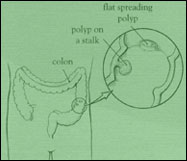Cancer of the colon is a major health problem in the United States. It ranks as a leading form of cancer, along with lung and breast cancer. Importantly, colon cancer is also one of the most curable forms of cancer. When detected early, more than 90 percent of patients can he cured.
This disease begins in the cells that line the colon. Now there is strong medical evidence that there are abnormal genes for colon polyps and cancer that can be passed from parent to child. The genes within each cell are the hereditary structures that tell the cell what it should do. It is becoming increasingly clear that these genes control the growth of the cells which oil the lining of the colon. When these controlling genes are absent there is a tendency to grow polyps. The cells in the polyp eventually become uncontrolled and turn into a cancer. Colon cancer also can develop from other conditions, such as ulcerative colitis, a chronic inflammation in the colon.
What is a Colon Polyp? A polyp is a growth that occurs in the colon and other organs. These growths, or fleshy tumors, are shaped like a mushroom or a dome-like button, and occur on the inside lining of the colon. They may be as small as a tiny pea or larger than a plum. It is important to note that while colon polyps start out as benign tumors, some polyps, in time, become malignant. In fact, the larger the polyp, the more likely it is to contain cancer cells. In most cases, it is a polyp called an adenoma polyp that develops into colon cancer.
A polyp is a growth that occurs in the colon and other organs. These growths, or fleshy tumors, are shaped like a mushroom or a dome-like button, and occur on the inside lining of the colon. They may be as small as a tiny pea or larger than a plum. It is important to note that while colon polyps start out as benign tumors, some polyps, in time, become malignant. In fact, the larger the polyp, the more likely it is to contain cancer cells. In most cases, it is a polyp called an adenoma polyp that develops into colon cancer.
What are the Risk Factors For Developing Colon Polyps and Cancer?
|
An individual whose parents, brothers or sisters have colon cancer is at increased risk. In addition, certain unusual conditions, such as hereditary polyposis, lead to colon cancer 100 percent of the time. Persons living and eating in Western societies are exposed to certain factors that are detrimental to the bowel. Medicine is just beginning to learn about these. Also, females who have had genital or breast cancer are at an increased risk of developing colon cancer. Ulcerative colitis, after a long time, also can lead to colon malignancy.
Detection
The key to early detection of colon polyps and cancer is the concern and willingness of each person to seek medical attention from a physician. The physician will perform the following:
|
